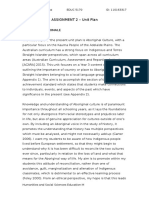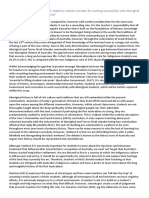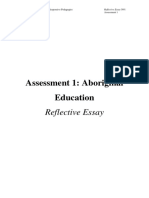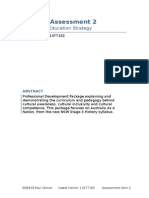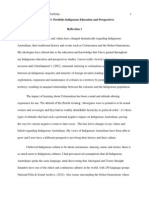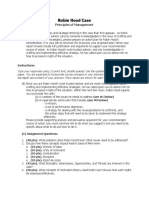Snell Kristya2
Snell Kristya2
Uploaded by
api-248878022Copyright:
Available Formats
Snell Kristya2
Snell Kristya2
Uploaded by
api-248878022Original Title
Copyright
Available Formats
Share this document
Did you find this document useful?
Is this content inappropriate?
Copyright:
Available Formats
Snell Kristya2
Snell Kristya2
Uploaded by
api-248878022Copyright:
Available Formats
Running head: Kristy Snell EDU10005. ASS2.
Essay
European colonialism has affected the lives of Indigenous Australians throughout history and up until the present time. Colonialism is a relationship between an Indigenous majority and minority of foreign invaders with the colonisers convinced of their own superiority and ordained mandate to rule (Osterhammel, 2005). The following essay contains two parts (A and B). Part A describes European colonialism and the effects on the lives of Indigenous Australians. From European settlement in 1788 the actions and events that took place have shaped and portray the history that Australia has today. Europeans held the misconception that Indigenous Australians had no claims to the land as they claimed it to be terra nullius (an empty land), therefore stripping the Indigenous Australians of their homes, their lands and their rights. Through intentional actions of the British to convert the Indigenous people to European civilization, confrontations and relationships between the two became evident, leading to unequal relations between the colonialists and the Indigenous population. Part B describes the support of teaching and learning Indigenous Australian languages within the education system, and what can be done to support Indigenous culture and history. Part A On January 26th 1788, Captain Arthur Phillip along with 290 sailors, marines and officials, and 717 convicts made their way by sea to arrive in Port Jackson and release the anchor in Warrang- Sydney Cove (Harrison, 2011). The British invaded this land that belonged to the Indigenous Australians from the Gadigal clan. Throughout Australia in the 1700s there were approximately 1,000,000 Indigenous people across Australia divided into 700 tribes consisting of many clans and extended family groups (Harrison, 2011). According to Harrison (2011) each
Running head: Kristy Snell EDU10005. ASS2. Essay
tribe had their own territories, political systems, laws and languages that were established by the Indigenous Australians. These systems proved to be effective as Aboriginal culture is over 1,000,000 years old. Many Indigenous Australians see themselves as autochthonous- that they have always been here; their life began thousands of years ago when the ancestors gave life to the land animals and people (Harrison, 2011). Throughout the 1780s Joseph Banks claimed the natives were peaceful and would soon abandon the land to new comers when he founded Botany Bay to be suitable for settlement as the British assumed that Indigenous Australians had no claims to the land (National Film and Sound Archive, 2012). European colonialism continued to take over the Indigenous Australians land and rights for decades following the invasion of Europeans immigrating to a land that was not theirs to claim as their own. Phillips 1788 settlement marked the start of regular contact between Europeans and the Indigenous Australians. Although many Aborigines used the land around Sydney as their dwellings and hunting domains, only a few major confrontations took place between the colonists and the indigenous population in the first decade of white settlement (Australian Migration, 2014). The official colonial policy throughout the 19th century was to treat the Aborigines as equals, with the intention of eventually converting them to Christianity and European civilization (Australian Migration, 2014). After the claims of Australias states and territories by the British government, the chief protector in each state had enormous power over Indigenous people. Governors responded in ways to teach the Indigenous people a lesson, in turn leading to fear and distrust of Europeans, avoiding them as much as possible regarding their culture as violent,
Running head: Kristy Snell EDU10005. ASS2. Essay brutal and uncivilized (NFSA, 2012). Colonialism can be seen as the establishment, exploration and expansion of colonies within a territory by people from another territory; a set of unequal relationships between the colonialists and the Indigenous population continued for many years throughout Australia. The British treated Australia as terra nullius, a Latin term meaning empty land. The doctrine of terra nullius remained the law in Australia throughout the colonial period (1700s) right up to 1993. Indigenous Australians adapted to extraordinary climate change, vastly different environmental realities, brutal invasion and conquest of their country (Boyce, 2008). European
colonialism had detrimental effects on the Indigenous Australians such as the Smallpox epidemic in 1789. It has been estimated that between 50 and 70 per cent of the Indigenous population in the Sydney area died within two years of the British arrival (My Place, 2011). Due to the lack of immunity within the Indigenous people, Smallpox deaths had profound effects on the social organization of their tribes and clans affecting Elders, pregnant women and young children. Government policy saw the era of the stolen generations, the generations of Indigenous people taken away from their families and remained in government policy until 1969. This affected the Indigenous people immensely, as almost every Aboriginal family was affected in one way or another. The removal of Indigenous people from their families had profound repercussions for many Indigenous Australians continuing into the present day. Government authorities disapproved of miscegenation and these children were removed as it was considered that the Aboriginality could be bred out of the child (Harrison, 2011). Throughout 1937-1960 Indigenous people were expected to live like non-indigenous people, adopting their cultures and language, known as the Assimilation Policy (Harrison, 2011).
Running head: Kristy Snell EDU10005. ASS2. Essay During the 1960s the Assimilation policy was replaced by Integration, allowing Indigenous people a choice to join the non-indigenous communities on equal terms (Harrison, 2011).
European colonialism was a harsh and devastating movement creating racism, beliefs and judgments based on views on the British wanting to create a settlement as they had problems with crime, violence and overcrowded jails. Colonialism caused Indigenous Australians to resort to destroying crops, animals, non-indigenous people, to attempt to regain control over their land and entitlements. Indigenous Australians gained constitutional rights decades later as citizens in 1967, followed by the first Indigenous Australian to be elected into federal parliament in 1972 (NFSA, 2012). Indigenous Australians lost their freedom, rights and privilege to exist when European colonialism invaded Australia beginning in 1788. Indigenous people were driven from their lands on died from unfamiliar diseases; as they were nomadic hunter-gatherers, they faced risk of starvation as colonization created a prevention to roam freely over their lands to search for food (Cultural Anthropology, 2011). Due to colonialism, much of the Indigenous culture was lost. Indigenous culture is told in the Dreaming, a time of creation in history, present and future where the spirits of the Indigenous people created the land, animals and people. The Dreaming stories reinforce prior Indigenous knowledge regarding sacred places, behaviour and land formations, that are passed down through generations to keep the story alive today. Traditional customs are also passed down through stories and demonstrations regarding connection to country and Indigenous languages. Country to Indigenous Australians means looking after and respecting my temple as it is my mother, my brother, siblings, animals and land as we are all one (Reconciliation Australia, 2010).
Running head: Kristy Snell EDU10005. ASS2. Essay
We cannot undo the atrocities that were committed in the founding of this nation, nor the many wrongs that have been done since. We can relearn our past and understand the choices made by our predecessors were not inevitable but were just that- choices (Maddison, 2011). Part B Early Childhood Australia (2012) states that a reconciliation plan involving respect, connect and enact to incorporate the transformation that moves ideologies from ignorance and racism to respect, from inequity and prejudice to justice, from inaction and fear to hope with the one promise for a strong future for every child is realized. Through actively engaging with Indigenous leaders and organisations, and to support effective national representation for Indigenous communities and children, by building relationships to drive for a positive change. Theory and practice are required to respond to acceptance of diversity, social cohesion, national identity, inclusive citizenship, empowerment and equity for Indigenous minorities (Nichol, 2011). Through the consideration and incorporation of elements of Indigenous pedagogy into the education system through learning, classroom practice and developmental projects to create the underpinnings associated within particular cultural agendas. According to Craven (2011), racism is often exacerbated by misconceptions and stereotypes that are products of historic ethnocentric attitudes asserting a superiority of one group over another. Indigenous perspectives need to be embedded across all syllabus areas, not as a theory we carry around in our heads, but in the practical day to day workings of the classroom (Jorgenson, Grootenboer, Sullivan, 2013). This can be seen in the Djidi Djidi School offering bicultural education involving national curriculum and culture (SBS on Demand, 2011). Djidi Djidi (2011) offers individualized programs based on individual needs of the children, this
Running head: Kristy Snell EDU10005. ASS2. Essay program has been running for two years and attendance is at 88 per cent, with the children
willing to learn. The school day begins with didgeridoo sounding over the speakers and a cultural dance to involve children in Indigenous Australian culture. Whilst the students develop competence in Standard Australian English (SAE), their home language is respected and valued. The students are given opportunities to use home language, Noongar and SAE at school. They are taught when to appropriately use each code (Department of Education, n.d). European colonialism including its ideologies and practices has predominantly undermined the use of Indigenous languages throughout Australia. As described in part A, colonialism removed the rights of Indigenous people to continue their culture and practices as their rights and privileges were removed upon settlement. In 1788 there were 250 distinct Indigenous languages in Australia, with each clan/tribe having its personal territory, political system, laws and languages (Harrison, 2011). Throughout 1937-1960s Indigenous people were expected to live aside non-indigenous people and to adopt their culture and language (Harrison, 2011). Through later government actions and policies reconciliation through building relationships plays a key part in such an integral part of Australian history. Developing knowledge and appreciation for Indigenous cultures through the education system to support the teaching and learning of Indigenous languages, as culture is part of Australian history. Bilingual education programs have no necessary detrimental effect on the learning of the dominant language and of mainstream subjects; in fact they may enhance learning in all curricular areas. Such programs create a strong link between the community and its culture, and decrease the alienation felt by Indigenous students in schools where teaching is by members of
Running head: Kristy Snell EDU10005. ASS2. Essay
the dominant community and takes place in a language which is not the students mother tongue (Simpson, Caffery & McConvell, 2009). Children begin to notice differences and construct their own classifications and evaluate categories at a young age. Society and bias influence childrens concepts, regarding Indigenous people according to history as the minority despite their existence for thousands of years. Throughout history it was thought that Indigenous Australians lacked in societal rules, governs, concepts and languages therefore were mistakenly portrayed as the minority compared to European settlers. This created the stereotypical beliefs that Indigenous people must adapt to European culture, through the removal of children to be placed in institutions. These actions meant that the Indigenous children were removed from their families, their culture, their community and their languages with the expectation to succumb to European culture. As this continued for decades Indigenous children were isolated from their cultural heritage, forced into learning European language, behaviour and culture through harsh educational systems and missions. The importance today of the Dreamings creates a bridge between the lost time in history and the present, enabling children to learn Indigenous Australian culture and language. Educators need to have an understanding of historical events such as European colonialism and the correct events that took place, perhaps to open their eyes and minds to an attitude that enables repair, regrowth, retelling and including Indigenous Australian culture within educational practices today. As discussed in part A and B, European colonialism has had devastating effects on the Indigenous people of Australia. The era of disease and the stolen generations affected Indigenous Australians almost beyond repair, and history gained a grim history full of tension,
Running head: Kristy Snell EDU10005. ASS2. Essay misconceptions, inequality and damaging persona. Much work has been done through government policies to repair the damage that has already been done. Implementing Indigenous Australian culture and perspectives that are supported within the education systems allow Indigenous and non-Indigenous children to build new relationships and repair previous beliefs and attitudes. The Dreaming is an important part of Indigenous Australian culture. This is required to be passed on and taught to children to gain the lost and perhaps forgotten past of the true Indigenous Australians.
Running head: Kristy Snell EDU10005. ASS2. Essay References Australian Migration. (2014). Retrieved from: http://www.australiamigration.com/page/history/238 Boyce, J. (2008). Van Diemens Land. Melbourne, Victoria: Black Inc Craven, R. (2011). Teaching Aboriginal studies a practical resource for primary and secondary teaching (2nd ed.). Crows Nest: Allen and Unwin.(Chapter 3). Cultural Anthropology. (2011). Retrieved from: http://curiosity.discovery.com/question/effect-english-colonization-aborigines Department of Education. (n.d). Djidi Djidi Aborigional School. Retrieved from:
http://webcache.googleusercontent.com/search?q=cache:KhW3VEaxIH4J:www.det.wa.e du.au/aboriginaleducation/detcms/cmsservice/download/asset/%3Fasset_id%3D13270061+&cd=3&hl=en&ct=clnk&gl=au Early Childhood Australia. (2012). Respect, Connect, Enact a Reconciliation Action plan for Early Childhood Australia 20122016. Retrieved from https://www.reconciliation.org.au/getfile?id=368&file=Early+Childhood+Australia+201 2-2016+RAP.pdf Harrison, N. (2011). Teaching and learning in Aboriginal education. South Melbourne, Victoria: Oxford University Press.
Running head: Kristy Snell EDU10005. ASS2. Essay Jorgenson, R., Grootenboer, P., & Sullivan, P. (2013). Pedagogies to enhance learning for Indigenous students. Evidence-based practice. Dordrecht: Springer. (pp. 1- 20). Maddison, S. (2011). Referendum, reconciliation and apology. in Beyond white guilt: The real challenge for black-white relations in Australia. Sydney: Allen and Unwin. (pp. 129143) My Place. (2011). Australia in the 1780s.Retrieved from:
10
http://www.myplace.edu.au/decades_timeline/1780/decade_landing_22.html?tabRank=3 &subTabRank=2 National Film & Sound Archive. (2012). Australian History Timeline [screen capture]. Retrieved from http://www.aushistorytimeline.com/ Nichol, R. (2011). Growing up Indigenous. Developing Effective Pedagogy for Education and Development. Rotterdam: Sense Publishers. (pp. 1-21) Osterhammel, J. (2005). Colonialism: A Theoretical Overview. Princeton, NJ: Markus Wiener Publishers. Reconciliation Australia. (2010). Welcome to and Acknowledgement of Country. Retrieved from http://www.reconciliation.org.au/home/resources/factsheets/q-afactsheets/welcome-to-and-acknowledgement-of-country
Running head: Kristy Snell EDU10005. ASS2. Essay SBS on Demand (2011) Djidi Djidi [Image and news broadcast] Retrieved from: http://www.sbs.com.au/ondemand/video/11765315673/Djidi-Djidi
11
Simpson, J., Caffery, J., McConvell, P. (2009). Gaps in Australias Indigenous Language Policy: Dismantling bilingual education in the Northern Territory. Australian Institute of Aboriginal and Torres Strait Islander Studies. Retrieved from: http://www.aiatsis.gov.au/research/docs/dp/DP24.pdf
You might also like
- 550 Sbas and MCQS: Mrcog Part 1Document10 pages550 Sbas and MCQS: Mrcog Part 1Rizka Adi33% (3)
- Educ4132 ExamDocument17 pagesEduc4132 Examapi-357680810No ratings yet
- Eeb435 A1Document15 pagesEeb435 A1api-327703697No ratings yet
- Part A: Scenario 1: RileyDocument10 pagesPart A: Scenario 1: Rileythunguyenhoang0303No ratings yet
- UNIT: EDU20003 Contemporary Perspectives of Learning and Development Assessment 2Document12 pagesUNIT: EDU20003 Contemporary Perspectives of Learning and Development Assessment 2thunguyenhoang0303100% (1)
- Lesson Plan 1 Edss428 Unit PlanDocument10 pagesLesson Plan 1 Edss428 Unit Planapi-281291423No ratings yet
- Assignment 1: Aboriginal Education (Critically Reflective Essay)Document11 pagesAssignment 1: Aboriginal Education (Critically Reflective Essay)api-355889713No ratings yet
- Final EssayDocument15 pagesFinal Essayapi-526201635No ratings yet
- Aboriginal and Culturally Responsive Pedagogies Assignment 1-Essay Option OneDocument6 pagesAboriginal and Culturally Responsive Pedagogies Assignment 1-Essay Option Oneapi-435781463No ratings yet
- Final Inquiry UnitDocument85 pagesFinal Inquiry Unitapi-567768018No ratings yet
- Edph Assessment 2 Unit of WorkDocument11 pagesEdph Assessment 2 Unit of Workapi-260503527No ratings yet
- Edss341 Unit Plan EdfdDocument20 pagesEdss341 Unit Plan Edfdapi-455597246No ratings yet
- The Gold Coast Transformed: From Wilderness to Urban EcosystemFrom EverandThe Gold Coast Transformed: From Wilderness to Urban EcosystemTor HundloeNo ratings yet
- Minor GamesDocument9 pagesMinor Gamesapi-328688284No ratings yet
- Howe Brianna 1102336 Task1 Edu202Document8 pagesHowe Brianna 1102336 Task1 Edu202api-457440156No ratings yet
- Assessment 2 - Case Study: Stephanie ChristelowDocument10 pagesAssessment 2 - Case Study: Stephanie Christelowapi-457784453100% (1)
- Assessment 2Document13 pagesAssessment 2api-320762430No ratings yet
- Critically Reflective EssayDocument9 pagesCritically Reflective Essayapi-478766515No ratings yet
- Assessment 3 Learning Plan Template Bush TuckerDocument2 pagesAssessment 3 Learning Plan Template Bush Tuckerapi-24844921250% (2)
- Primary Science Year 2 FPDDocument25 pagesPrimary Science Year 2 FPDapi-451099210No ratings yet
- Research Paper - Angela Carolina RoennauDocument16 pagesResearch Paper - Angela Carolina RoennauCarolina RoennauNo ratings yet
- Evana Loucas 110163317 Hass Assignment 2 Unit PlanDocument21 pagesEvana Loucas 110163317 Hass Assignment 2 Unit Planapi-297230954100% (2)
- 2014-2-Edu20005 Sustainable Education and Perspectives Assessment 3 Folio Final Fiona Pidgeon 657999xDocument16 pages2014-2-Edu20005 Sustainable Education and Perspectives Assessment 3 Folio Final Fiona Pidgeon 657999xapi-248449212100% (2)
- La Perouse - Contested Spaces-2Document22 pagesLa Perouse - Contested Spaces-2api-321063684No ratings yet
- Reflection Acrp FinalDocument4 pagesReflection Acrp Finalapi-357662510No ratings yet
- Critically Reflective EssayDocument7 pagesCritically Reflective Essayapi-460524150No ratings yet
- Science Unit of Work - Emily DwyerDocument30 pagesScience Unit of Work - Emily Dwyerapi-335773558No ratings yet
- Aboriginal Reflection 2 - 2Document6 pagesAboriginal Reflection 2 - 2api-407999393No ratings yet
- Group Member Lesson Plan Outline Curriculum Area Covered and Link To Your SiteDocument11 pagesGroup Member Lesson Plan Outline Curriculum Area Covered and Link To Your Siteapi-408784350No ratings yet
- Assignment 3 Hass Unit PlanDocument8 pagesAssignment 3 Hass Unit Planapi-626567329No ratings yet
- Assessment 2 Critical EssayDocument7 pagesAssessment 2 Critical Essayapi-525241634No ratings yet
- What Are Some of The Key Issues' Teachers Need To Consider For Working Successfully With Aboriginal and Torres Strait Islander Students?Document4 pagesWhat Are Some of The Key Issues' Teachers Need To Consider For Working Successfully With Aboriginal and Torres Strait Islander Students?api-465449635No ratings yet
- Ecp711 Assignment 1Document9 pagesEcp711 Assignment 1api-169564846No ratings yet
- Assessment 1: Aboriginal Education: Reflective EssayDocument8 pagesAssessment 1: Aboriginal Education: Reflective Essayapi-332298416No ratings yet
- EDU30064 Teaching Science - FolioDocument15 pagesEDU30064 Teaching Science - FolioMarnie JanineNo ratings yet
- EssayDocument13 pagesEssayapi-361229755No ratings yet
- Assessment 3 Educ 4726 - Unit and Essay-1Document13 pagesAssessment 3 Educ 4726 - Unit and Essay-1api-454928727No ratings yet
- Educ2420 Final Essay Part 1 CsvilansDocument3 pagesEduc2420 Final Essay Part 1 Csvilansapi-359286252No ratings yet
- Module 5 Diverse LearnersDocument5 pagesModule 5 Diverse Learnersapi-319072082No ratings yet
- Unit Outline Aboriginal FinalDocument12 pagesUnit Outline Aboriginal Finalapi-330253264No ratings yet
- Acrp Unit OutlineDocument14 pagesAcrp Unit Outlineapi-321145960No ratings yet
- Evidence Standard 1 2Document12 pagesEvidence Standard 1 2api-368761552No ratings yet
- Edu410 Reflective PortfolioDocument8 pagesEdu410 Reflective Portfolioapi-412566974No ratings yet
- Assignment Two Unit PlanDocument12 pagesAssignment Two Unit Planapi-334024915No ratings yet
- Rimah Aboriginal Assessment 1 EssayDocument8 pagesRimah Aboriginal Assessment 1 Essayapi-376717462No ratings yet
- One TeacherDocument7 pagesOne Teacherapi-235065651100% (1)
- Overview of Site Organisation of Unit of Work Unit of Work Community EngagementDocument27 pagesOverview of Site Organisation of Unit of Work Unit of Work Community Engagementapi-409698216No ratings yet
- Alisha Rasmussen - 19059378 - Assessment One - Aboriginal and Culturally Responsive PedagogyDocument15 pagesAlisha Rasmussen - 19059378 - Assessment One - Aboriginal and Culturally Responsive Pedagogyapi-466919284No ratings yet
- Jane Sparrow 20144178Document14 pagesJane Sparrow 20144178api-393907178No ratings yet
- Integrated Life Cycle Lesson PlanDocument3 pagesIntegrated Life Cycle Lesson Planapi-240700556No ratings yet
- Assessment 2 - Unit OutlinesDocument14 pagesAssessment 2 - Unit Outlinesapi-430008440No ratings yet
- Final EssayDocument6 pagesFinal Essayapi-375391245No ratings yet
- Aboriginal & Culturally Responsive Pedagogies: Critical Reflective EssayDocument9 pagesAboriginal & Culturally Responsive Pedagogies: Critical Reflective Essayapi-460175800No ratings yet
- Campbell Chloe 1088079 Edu412 Task1Document8 pagesCampbell Chloe 1088079 Edu412 Task1api-453388446No ratings yet
- Inclusive Assessment 1Document10 pagesInclusive Assessment 1api-483696979No ratings yet
- Acrp Assessment 2 EssayDocument9 pagesAcrp Assessment 2 Essayapi-533984328No ratings yet
- Edfd452 Evidence - Edss341 A3Document21 pagesEdfd452 Evidence - Edss341 A3api-358837015No ratings yet
- Unit PlannerDocument2 pagesUnit Plannerapi-318426610No ratings yet
- Planning Documents University of Notre Dame: Early ChildhoodDocument16 pagesPlanning Documents University of Notre Dame: Early Childhoodapi-347783593No ratings yet
- Assessment 2Document14 pagesAssessment 2api-297389221No ratings yet
- Edfd452 Evidence - Edss341 A3Document21 pagesEdfd452 Evidence - Edss341 A3api-358837015No ratings yet
- Creating the Citizens of the Future: How Global Education is Critical to SuccessFrom EverandCreating the Citizens of the Future: How Global Education is Critical to SuccessNo ratings yet
- Snell Kristya3Document9 pagesSnell Kristya3api-248878022100% (1)
- Snell Kristya1Document6 pagesSnell Kristya1api-248878022No ratings yet
- Kristy Snella3Document9 pagesKristy Snella3api-248878022No ratings yet
- Kristysnella 1Document6 pagesKristysnella 1api-248878022No ratings yet
- Snell Kristya2Document13 pagesSnell Kristya2api-248878022No ratings yet
- Snell Kristya1Document2 pagesSnell Kristya1api-248878022No ratings yet
- Snell Kristya2Document12 pagesSnell Kristya2api-248878022No ratings yet
- Individual Assignment Coversheet - Psychology and Education UnitsDocument9 pagesIndividual Assignment Coversheet - Psychology and Education Unitsapi-248878022No ratings yet
- Individual Assignment Coversheet - Psychology and Education UnitsDocument10 pagesIndividual Assignment Coversheet - Psychology and Education Unitsapi-248878022No ratings yet
- Final Part I Kri CVDocument2 pagesFinal Part I Kri CVapi-219804660No ratings yet
- Lesson 1 Translation StudiesDocument17 pagesLesson 1 Translation Studiesbages82No ratings yet
- The HeronBridge College Term One Edition 1 2019 ReviewDocument13 pagesThe HeronBridge College Term One Edition 1 2019 ReviewChange MbathaNo ratings yet
- Back To BasicsDocument7 pagesBack To Basicsapi-239011467No ratings yet
- A Content Analysis of Education and Good Governance in Public Schools of PakistanDocument4 pagesA Content Analysis of Education and Good Governance in Public Schools of PakistanThe Explorer IslamabadNo ratings yet
- Detailed Lesson Plan (DLP) Format: Learning Competency/ies: CodeDocument4 pagesDetailed Lesson Plan (DLP) Format: Learning Competency/ies: Codemarichie t. sabequilNo ratings yet
- Practicum Report-4Document1 pagePracticum Report-4Mazhar ShahzadNo ratings yet
- Robin Hood Case Instructions ADocument2 pagesRobin Hood Case Instructions ABruce OderaNo ratings yet
- Contextual LearningDocument37 pagesContextual LearningUlana MasitohNo ratings yet
- Status of Social ScienceDocument1 pageStatus of Social ScienceImmanuelRuataNo ratings yet
- LAC Activity DesignDocument2 pagesLAC Activity DesignEvan Siano Bautista90% (10)
- Colour (Vocabulary Worksheets) : 1 Match The Colours With The Natural Things They DescribeDocument3 pagesColour (Vocabulary Worksheets) : 1 Match The Colours With The Natural Things They DescribeVirginia AlvarezNo ratings yet
- Dead Poets Society Vocabulary WorksheetDocument4 pagesDead Poets Society Vocabulary WorksheetAnna Costikoglou100% (2)
- Iep FinalDocument31 pagesIep Finalapi-443892331No ratings yet
- FS 1 Learning Episode 8Document20 pagesFS 1 Learning Episode 8damacion2020No ratings yet
- Curriculum VitaeDocument6 pagesCurriculum VitaeThembalihle Reuben Mdutshane100% (1)
- Problem Solving RusczykDocument2 pagesProblem Solving RusczykBuried_ChildNo ratings yet
- Culture and Language in TextbooksDocument7 pagesCulture and Language in TextbooksHatim DliaaNo ratings yet
- Unit TestDocument7 pagesUnit Testapi-277919024No ratings yet
- ZugabDocument2 pagesZugabShisha ShishichNo ratings yet
- PD MT 2 Managing Multigrade Classroom StudentDocument45 pagesPD MT 2 Managing Multigrade Classroom StudentVanessa V. Rutaquio100% (1)
- Just Mercy Lessons ParkDocument25 pagesJust Mercy Lessons Parkapi-355737575No ratings yet
- Singer's Self ReflectionDocument2 pagesSinger's Self ReflectionCaleb GrochalskiNo ratings yet
- BIA 652 Syllabus Spring 2017Document5 pagesBIA 652 Syllabus Spring 2017Henry MorenoNo ratings yet
- First and Second Language AcquisitionDocument3 pagesFirst and Second Language AcquisitionCristian Diego López BarreraNo ratings yet
- Second Quarter SmeaDocument4 pagesSecond Quarter SmeaRainel Manos88% (8)
- 0610 s14 Ms 61 PDFDocument6 pages0610 s14 Ms 61 PDFCorinSaputraNo ratings yet
- Lesson Plan Template For USM EDU ProgramDocument2 pagesLesson Plan Template For USM EDU Programapi-387653492No ratings yet





















